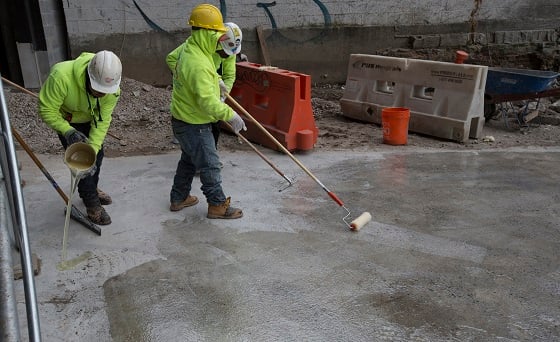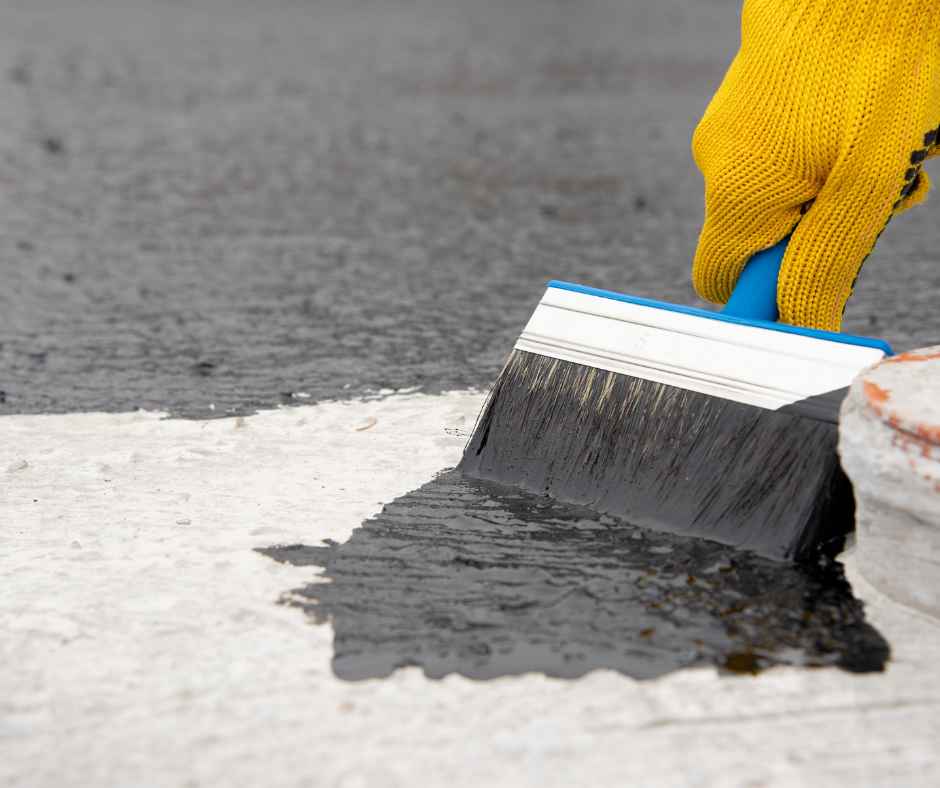Signs You Need a Drainage & waterproofing company Omaha Before It’s Too Late
Exactly How Waterproofing Works: A Detailed Check Out Strategies and Technologies
Waterproofing is necessary for protecting structures from moisture-related damages. It includes various strategies and innovations that create obstacles against water intrusion. Typical techniques, such as compacted clay, exist side-by-side with contemporary technologies like liquid-applied membrane layers. Understanding the subtleties of these methods is important for reliable application. The efficiency of any kind of waterproofing option hinges not only on the strategies utilized yet likewise on recurring maintenance and examination. What are the essential factors that influence lasting performance?
Understanding the Essentials of Waterproofing
Waterproofing is a necessary process that safeguards frameworks from water intrusion, which can cause considerable damage in time. This approach involves the application of different products and strategies created to develop a barrier against wetness. The key goal is to avoid water from penetrating surface areas, which can create wear and tear, mold development, and architectural instability.Various factors influence the option of waterproofing approach, consisting of the kind of structure, its location, and environmental conditions. Comprehending the physics of water activity and the homes of various products is critical in selecting a reliable waterproofing solution.Effective waterproofing not just safeguards structures yet additionally boosts their long life and honesty. Typically, it is integrated into the design phase of building to ensure detailed protection. As awareness of water-related issues grows, the importance of understanding waterproofing fundamentals becomes increasingly clear to architects, contractors, and residential or commercial property owners alike.
Conventional Waterproofing Techniques
Conventional waterproofing methods have been utilized for centuries, relying upon reliable methods and materials to safeguard frameworks from water damage. One of the oldest approaches includes using clay, which, when compacted, creates an all-natural obstacle against moisture. In addition, asphalt, a sticky, black material acquired from oil, has been employed for its waterproof buildings, commonly related to roofs and foundations.Another strategy involves the application of lime-based plasters, which provide a breathable layer that permits wetness to escape while preventing water access. Thatch roofing, a typical approach still seen in some cultures, offers superb waterproofing due to its securely packed straw layers.Moreover, the use of rock and brick has actually projected, as these materials are inherently immune to water when correctly mounted. Generally, traditional waterproofing techniques emphasize the value of selecting suitable products and building techniques to improve resilience versus water intrusion.
Modern Waterproofing Technologies
Innovations in modern-day waterproofing modern technologies have transformed the method structures are shielded from water damage. Ingenious approaches such as liquid-applied membrane layers and innovative sealants have improved the performance and adaptability of waterproofing services. These innovations enable seamless application, minimizing the threat of leakages and making sure comprehensive insurance coverage over intricate surfaces.Moreover, the integration of wise innovations, such as dampness sensing units and automated tracking systems, makes it possible for real-time assessment of waterproofing performance. This positive technique promotes timely upkeep and lowers long-term repair work costs.Additionally, improvements in spray-applied layers provide fast application and superb adhesion, adjusting to various substratums while giving durable defense. Techniques like polymer-modified systems even more improve versatility and sturdiness, making them appropriate for diverse atmospheres. In general, contemporary waterproofing innovations not just mitigate water intrusion but also add to the longevity and sustainability of frameworks, marking a significant change in the market.
Products Made Use Of in Waterproofing
The effectiveness of waterproofing options greatly counts on the products made use of in their application. Various materials are utilized to create barriers against water access, each with special residential or commercial properties suited for various settings. Typically made use of products include membranes, coverings, and sealants.Liquid-applied membranes, usually made from polyurethane or acrylic, develop a smooth barrier that adjusts to intricate surfaces. Sheet membrane layers, usually created from rubber or polycarbonate, offer resilience and are ideal for bigger areas. In addition, cementitious waterproofing materials, made up of cementitious compounds, give excellent attachment and flexibility.Sealants made from silicone or polyurethane are vital for joints and seams, making certain complete protection. In addition, sophisticated products, such as geo-composite membranes, integrate numerous features, enhancing performance. Generally, the selection of waterproofing materials is crucial in achieving lasting and reliable water resistance, tailored to particular task requirements and environmental conditions.
Usual Applications of Waterproofing
Waterproofing plays an important function in numerous sectors, guaranteeing the long life and honesty of structures. Common applications include property remedies that safeguard homes, industrial facilities that safeguards organizations, and industrial settings that need durable security versus dampness. Understanding these applications highlights the significance of waterproofing in preserving both safety and security and functionality across different settings.
Residential Waterproofing Solutions
Several property owners deal with obstacles with moisture invasion, making efficient household waterproofing solutions important. Different approaches exist to resolve this problem, consisting of exterior and interior waterproofing systems. Inside remedies often involve the application of sealers and layers to cellar walls, which assist stop water infiltration. Exterior approaches commonly consist of the installment of water drainage systems and water-proof membrane layers that draw away water far from the foundation.Additionally, homeowners may take into consideration sump pumps to remove water build-up and dehumidifiers to regulate humidity levels. Appropriate grading and using seamless gutters also play an important role in taking care of water circulation around the home. By implementing these approaches, property owners can substantially lower the threat of water damages and mold development, guaranteeing a dry and secure living setting.

Commercial Infrastructure Security
Efficient waterproofing options play a critical role in the protection of commercial infrastructure. Sump pump installation & replacement Omaha. These methods are vital for guarding structures, car park frameworks, and bridges from water damages, which can jeopardize structural integrity and lead to pricey repair services. Typical applications consist of the setup of membranes, coverings, and sealants that create obstacles versus wetness infiltration. Areas such as cellars, roof coverings, and exterior wall surfaces are usually prioritized to assure long life and durability. In addition, waterproofing systems can boost power performance by protecting against water-related problems that may lead to mold and mildew growth and deterioration. By implementing durable waterproofing procedures, homeowner can protect their financial investments and preserve functional effectiveness, eventually adding to the general sustainability of commercial centers
Industrial Applications Summary
While different fields face special obstacles, the demand for dependable waterproofing options continues to be a consistent in industrial applications. Industries such as manufacturing, building, and power often experience atmospheres where moisture exposure can endanger architectural integrity and operational efficiency. In manufacturing facilities, waterproofing is vital for securing equipment and products from water damage. In building, it safeguards structures and basements against groundwater infiltration. The energy sector depends on waterproofing for the protection of equipment in hydroelectric plants and offshore structures. Furthermore, food processing markets use waterproofing to ensure hygiene and compliance with safety standards. In general, efficient waterproofing options are necessary for improving toughness, security, and efficiency across numerous commercial setups.
Maintenance and Longevity of Waterproofing Solutions
Waterproofing solutions are designed to use long-lasting protection versus wetness intrusion, normal maintenance is important websites to guarantee their performance and durability. Regular assessments play a considerable duty in determining potential concerns such as fractures, peeling off, or indications of water damages. Dealing with these troubles quickly can protect against additional deterioration and expensive repairs.Additionally, cleaning the surface of waterproof areas assists get rid of dirt and particles that might endanger the stability of the waterproofing barrier. It's also recommended to reapply safety finishes or sealants as suggested by manufacturers about his to preserve ideal performance. Ecological variables, such as UV exposure and extreme weather condition problems, can affect the life expectancy of waterproofing products, making normal assessment important
Regularly Asked Inquiries
Can Waterproofing Be Applied in Cold Climate?
The question of applying waterproofing in chilly climate elevates concerns about bond and treating. Numerous items might not execute at their ideal in low temperatures, necessitating careful option and consideration of particular guidelines for efficient application.
Exactly How Long Does Waterproofing Normally Last?
The period of waterproofing performance varies based on materials and ecological variables. Usually, it can last from 5 to 10 years, however normal maintenance and inspections are crucial to guarantee peak efficiency and long life.
Is DIY Waterproofing Effective and Safe?
The effectiveness and security of DIY waterproofing depend upon various aspects, consisting of material quality and application technique. While some people accomplish satisfactory outcomes, others might come across problems that compromise long-term defense and architectural honesty.
What Are the Indicators of Failing Waterproofing?
Indicators of stopping working waterproofing include noticeable water discolorations, peeling paint, mold development, moldy odors, and wetness in walls or ceilings - Landscape drainage Omaha. These indicators recommend directory jeopardized obstacles, requiring punctual evaluation and prospective removal to stop further damages
Exactly how Do I Choose the Right Waterproofing Service Provider?
